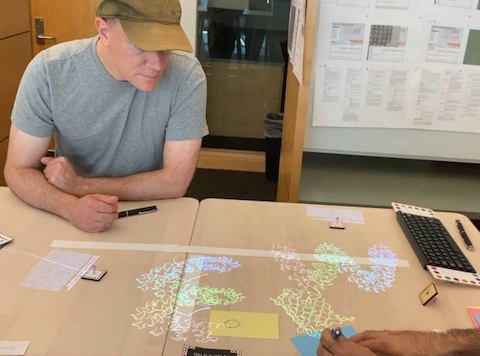Interactive worlds and Dynamicland — Sun 08 September 2024
There's long been interest in physical embodiment of systems for working with computing to explore the world, including the long-term project now hosted at the Dynamicland Foundation "to enable universal literacy in a humane computational medium". Also evident in the work of the Raspberry Pi Foundation (now funded by Raspberry Pi Holdings plc) giving students the tools for creating embedded computing.

Image: Dynamicland Foundation
Dynamicland Foundation has built on earlier experiments by its researcher Bret Victor of providing tools to visualize computer simulations (see one of his popular talks from over a decade ago Inventing on Principle). But as with many endeavours which have longevity, there is also an underlying ideal; in this case…
"Finding a guiding principle for your work, something you believe is important and necessary and right, and using that to guide what you do" —Bret Victor.
One principle, is finding ways to subvert the notion that most computing is not performed in a social, immediate, physically-shared space—an activity which people have valued to cooperate on exchanging knowledge over millennia. Exceptions are the sort of activities done in 'Pi Jams' where makers share knowledge of physical computing; eg building robots, which are then set off on adventures in real space. But even so the coding in these venues often consists of the participants typing away on their individual laptops; making it tricky to easily share that act of building code.
The approach by Dynamicland has been to move the code into physical objects; such as playing card-sized tokens which can be moved on a table to build up coding scenes. Where currently traditional code is needed to give these objects a function, a page of code can be laid out on the table, recognized by camera systems and incorporated into the system being designed.
This is diametrically opposite to how corporations are steering computing environments (in these heady days-but see Bret Victor's wry look at extrapolation of computing tech. from the 1960's to today). In the corporations' approach it's people who are forced to adapt to computing devices by wearing goggles and entering a rendered virtual landscape. In Dynamicland experiments, the computing itself merges into the real world and becomes an adjunct to paper, sharpie pens and models constructed to serve the discussion, Blue Peter-style with props made from recycled food containers and hand-drawn diagrams.[^1] People remain in the world which they're familiar with and have always inhabited.
[^1]: A UK TV programme of the 60s-90s for children of all ages; once (in)famous for building toys from coat-hangers and sticky-backed plastic. But now clearly ahead of its time by decades.
The best way to get an idea for the resulting experience (which the Foundation has nurtured with loads of real-life workshop sites), is to browse their newly-updated website whose index page is a view of a set of bookshelves displaying the computing artifacts (pages from ring-binders) which are the tangible result of ongoing research.
Finally, I'm really hoping that the star of tomorrow's Apple event will be a (very tastefully designed) ring binder, and some slick spatial interface devices to bring hand-crafted worlds into the realm of iOS and macOS. But I won't hold my breath…